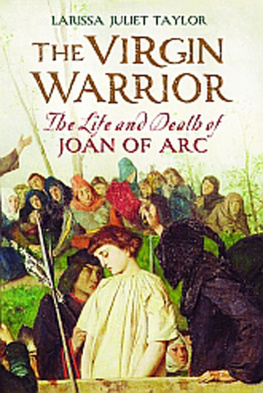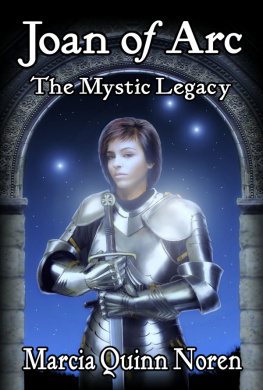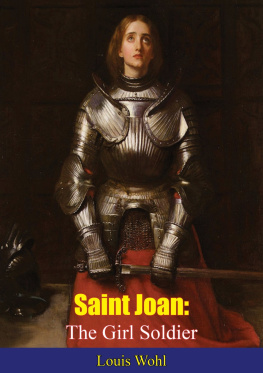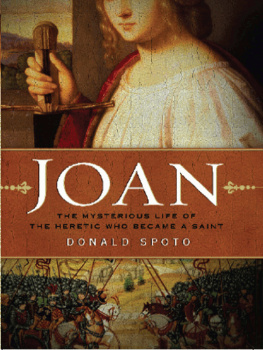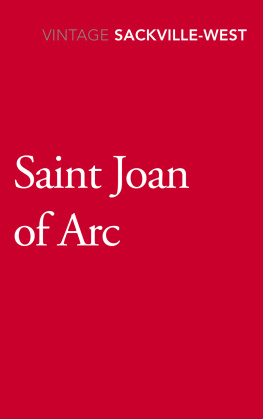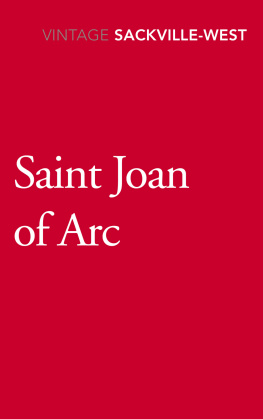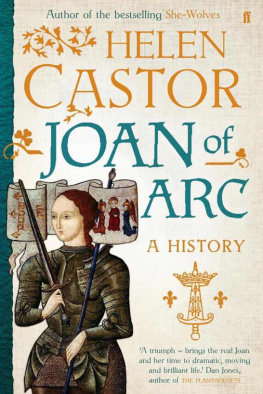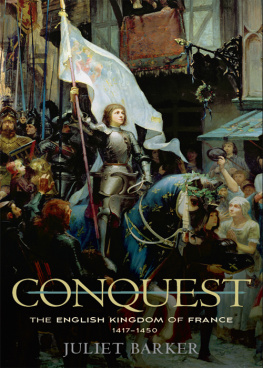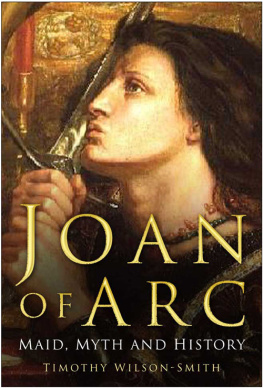The Virgin Warrior
The Virgin Warrior
T HE L IFE AND D EATH OF J OAN OF A RC

LARISSA JULIET TAYLOR
YALE UNIVERSITY PRESS
NEW HAVEN AND LONDON
Copyright 2009 Larissa Juliet Taylor
All rights reserved. This book may not be reproduced in whole or in part, in any form (beyond that copying permitted by Sections 107 and 108 of the U.S. Copyright Law and except by reviewers for the public press) without written permission from the publishers.
For information about this and other Yale University Press publications, please contact:
U.S. Office: sales.press@yale.edu www.yalebooks.com
Europe Office: sales@yaleup.co.uk www.yalebooks.co.uk
Set in Adobe Caslon Regular by IDSUK (DataConnection) Ltd
Printed in Great Britain by TJ International Ltd, Padstow, Cornwall
Library of Congress Cataloging-in-Publication Data
Taylor, Larissa.
Joan of Arc : the maid of Lorraine / Larissa Juliet Taylor.
p. cm.
Includes bibliographical references and index.
ISBN 978-0-300-11458-4 (cloth : alk. paper)
1. Joan, of Arc, Saint, 14121431. 2. Joan, of Arc, Saint, 14121431Military leadership. 3. Christian women saintsFranceBiography. 4. Women soldiersFranceBiography.
5. FranceHistoryCharles VII, 14221461. I. Title.
DC103.T39 2009 944'.026092
[B] 2009007424
A catalogue record for this book is available from the British Library.
10 9 8 7 6 5 4 3 2 1
Biblical quotations from The New Revised Standard Version with Apocrypha, copyrighted 1962, 1973, 1977 by Oxford University Press.
F OR
M Y BEST FRIEND AND MUSE , K ITIKAT
Contents
Illustrations

1 Joan of Arc's house, Domremy. Author's photograph.
2 Church of St. Remy, Domremy. Author's photograph.
3 Statue of Joan near the Fairies or Ladies' Tree. Author's photograph.
4 Chapel of Notre Dame de Bermont. Author's photograph.
5 Gate of France, Vaucouleurs. Author's photograph.
6 Church of Saint-Catherine of Fierbois. Author's photograph.
7 Chinon Castle. Author's photograph.
8 Jean Fouquet, portrait of Charles VII. Photo Ann Rona/HIP/Scala, Florence, 2005.
9 Saumur Castle. Author's photograph.
10 House of Jacques Boucher, Orlans. Author's photograph.
11 Jean-Jacques Scherrer, The Entrance of Joan of Arc Into Orlans on May 8, 1429, c. 1870. Muse Jeanne d'Arc, Rouen.
12 Unknown artist, portrait of Jean Dunois, the Bastard of Orleans, 15th century. Private Collection, Archives Charmet / The Bridgeman Art Library.
13 Beaugency Castle. Author's photograph.
14 Notre Dame of Reims Cathedral. Author's photograph.
15 Statue of Joan with her banner in Reims Cathedral. Author's photograph.
16 Equestrian statue of Joan outside Reims Cathedral. Author's photograph.
17 Joan of Arc at the siege of Paris, in Martial d'Auvergne, Vigiles de Charles VII, f.66v. Photo Bibliothque nationale de France.
18 Clment de Fauquembergue, pen-and-ink sketch of Joan of Arc, 10 May 1429.
19 Joan threatening camp followers with her sword, in Martial d'Auvergne, Vigiles de Charles VII, f.60v. Photo Bibliothque nationale de France.
20 Castle of Sully-sur-Loire. Published by GNU Free Document License.
21 Church of Saint-Jacques, Compigne. Author's photograph.
22 Keep of Chteau de Bouvreuil, Rouen. Author's photograph.
23 North side of Saint-Ouen. Author's photograph.
24 Trial record signed by the notaries. Author's photograph.
25 Model of Joan at the stake. With permission from the Muse Jeanne d'Arc, Rouen.
26 The exact location of Joan's execution at the base of the cross, Rouen. Author's photograph.
Maps
England, France and Burgundy in the Hundred Years War.
The Meuse Valley from Vaucouleurs to Neufchteau.
Domremy's position on the border of France in the late fourteenth century and its strategic importance along the route from Flanders to Dijon.
From Vaucouleurs to Chinon.
Orlans's position at the northern edge of French-controlled territory.
The city of Orlans at the time of the siege.
The Loire campaign.
Joan's last campaigns.
Compigne in the fifteenth century.
Joan's route to captivity and execution, MarchMay 1430.
Normandy in the Hundred Years War.
Acknowledgements
I CAME TO THE STUDY of Joan late, without the fascination or adoration so many authors mention. After seeing a spate of films based on her life in the late 1990s, I became interested in Joan as a historical figure. Prior to that she had seemed an anomaly, and I resisted studying one of the few exceptional women who had made their way into my college textbooks in the 1970s. Her accomplishments, which seem impossible even in a more egalitarian modern age, began to intrigue me, and in 2000 I started teaching a senior seminar on Joan. Thanks to my students, the course has provided extraordinary insights into the woman. On the first day, when asked to give their impressions of Joan, they give predictable responses: that she was anorexic, schizophrenic, or psychologically deluded. It does not take long for them to realize how simplistic and just plain wrong such assumptions are. Joan's physical and emotional strength, recovery from wounds and falls, and her plainspoken eloquence all give the lie to such categorizations. Reading first secondary and then primary sources, students begin to see the complexities in Joan that are too often masked by the desires of screenwriters and biographers to dramatize the story.
My first debt of gratitude is owed to those students whose work has inspired me. I would especially like to thank Adam (Sam) Boss, my brilliant, talented, and indefatigable research assistant for three years, whose study of the Journal du sige d'Orlans and other fifteenth-century chronicles and military works made my work much easier. Sam has been at my right hand almost since the project began and beyond his graduation from Colby. His insights and suggestions have provided me with fresh ideas and arguments. Thanks also go to Ben Davis, Melissa Murray, Becky Anderson, Cynthia Anderson-Bauer, Meade Barlow, Lauren Baumgarten, David BurtonPerry, Camille Dugan Campanile, Shannon Corliss, Jenny Cox, Tim Cronin, Margo Derecktor, Meg Distinti, Sarah Eilers, Mike Feldman, Julia Gilstein, Rob Girvan, Juliana Green, Paige Hanzlik, Kirsten Isaksen, Kate Crocker Jordan, Annie Kearney, Sam Kennedy-Smith, Jess Laniewski, Lindsay Masters, David Mitchell, Kate Nevius, Katie Packard, Laura Perille, Kyle Ross, Sarah Ross-Benjamin, Neila Sage, Scarlett Slenker, Meg Smith, Jason St. Pierre, Eric Strome, Tara Sweeney, Sarah Thein, Cathy White, Ted Wright, and Mary Zito.
I would also like to thank the staff of the Colby College library, especially Eileen Fredette and Kathy Corridan, who procured hard-to-find books and medieval city maps, along with Peggy Menchen, Alisia Wygant, and Anna Graves for their research into flora and fauna in the Vosges region. The French Department at Colby, especially Marina Davies, Valrie Dionne, Jane Moss, Adrianna Paliyenko, and Jonathan Weiss, provided invaluable assistance in understanding the meaning of particularly difficult words or phrases. Members of the Maine Medievalist Association, especially my colleagues Elisa Narin van Court, Vronique Plesch, and Katharine Lualdi, all offered helpful suggestions. Many of my early ideas developed at conference presentations at the International Medieval Congress at Kalamazoo, the Sixteenth Century Studies Conference, and Renaissance Society of America. I would like to thank my colleagues in the International Joan of Arc Society, especially Gail Orgelfinger, Ann W. Astell, Kelly DeVries, Daniel Hobbins, Deborah Fraioli, Jane Marie Pinzino, Nadia Margolis, Bonnie Wheeler and many others. To all those who attended conference or invited presentations and offered helpful suggestions and comments, my debt is enormous. Any errors are mine alone.
Next page
